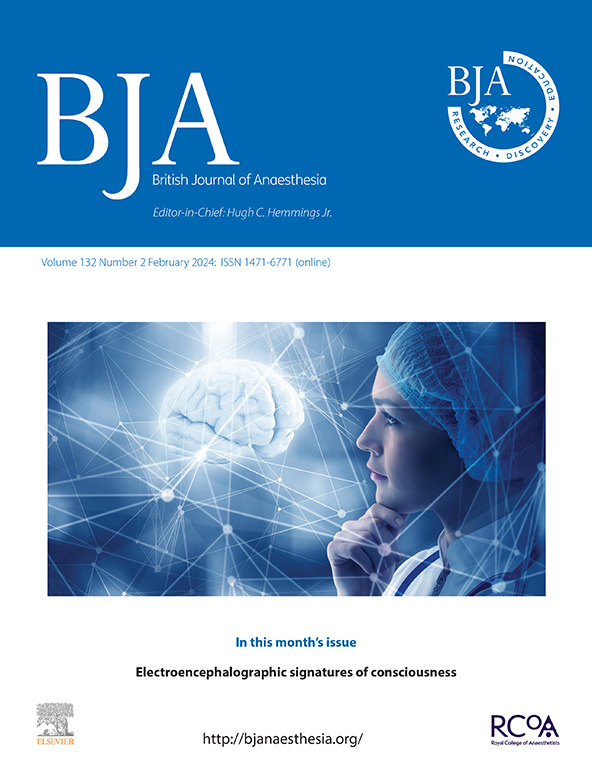Frailty and long-term survival of non-cancer patients admitted to intensive care after surgery: a retrospective multicentre cohort study.
IF 9.1
1区 医学
Q1 ANESTHESIOLOGY
引用次数: 0
Abstract
BACKGROUND As the global population ages and older patients undergo surgery, understanding the association between frailty and postoperative outcomes is crucial to informed decision-making and patient care. There is a lack of research assessing the association between frailty and long-term outcomes in patients admitted to ICUs after surgery. METHODS We conducted a multicentre retrospective cohort study using Australian and New Zealand Intensive Care Society Adult Patient Database, linked with the Australian National Death Index. Adults aged ≥16 yr admitted to the 175 ICUs in Australia between January 1, 2018, and March 31, 2022, after surgery were included. We excluded patients with cancer or admission to ICU for palliation or organ donation purpose. Patients with Clinical Frailty Scale score 5-8 were considered frail. The primary outcome was survival time up to 4 yr after ICU admission. Survival analysis was performed using mixed-effects Cox regression models and adjusted for age, sex, comorbidities, acute illness severity, and hospital types. RESULTS We included 216 922 patients of whom 30 860 (14.2%) were frail. Patients with frailty had shorter overall survival time (median [IQR]: 16 [6-29] vs 21 [10-34] months; P<0.01) when compared with patients without frailty. After adjusting for confounders, frailty was associated with a shorter time to death (HR: 2.33, 95% CI: 2.26-2.40). This association was consistent across sensitivity analyses and subgroups. Of note, this association between frailty and shorter time to death was more pronounced in patients aged <65 yr, those undergoing elective surgery, and those without treatment limitations. CONCLUSIONS In this multicentre study, frailty was associated with shorter time to death amongst postoperative ICU patients without cancer. The association was concordant across all subgroups.术后接受重症监护的非癌症患者的虚弱和长期生存:一项回顾性多中心队列研究
背景随着全球人口老龄化和老年患者接受手术,了解虚弱与术后预后之间的关系对知情决策和患者护理至关重要。我们利用澳大利亚和新西兰重症监护协会成人患者数据库与澳大利亚国家死亡指数进行了一项多中心回顾性队列研究。研究纳入了 2018 年 1 月 1 日至 2022 年 3 月 31 日期间澳大利亚 175 家重症监护病房收治的手术后年龄≥16 岁的成人患者。我们排除了癌症患者或因姑息治疗或器官捐献而入住重症监护病房的患者。临床虚弱量表评分 5-8 分的患者被视为虚弱患者。主要结果是入住重症监护室后 4 年内的存活时间。生存期分析采用混合效应 Cox 回归模型,并对年龄、性别、合并症、急性病严重程度和医院类型进行了调整。与非体弱患者相比,体弱患者的总生存时间较短(中位数[IQR]:16 [6-29] 对 21 [10-34] 个月;P<0.01)。对混杂因素进行调整后,虚弱与较短的死亡时间相关(HR:2.33,95% CI:2.26-2.40)。这种关联在不同的敏感性分析和亚组中都是一致的。值得注意的是,在年龄小于 65 岁、接受择期手术和无治疗限制的患者中,虚弱与缩短死亡时间之间的关系更为明显。结论 在这项多中心研究中,在无癌症的术后 ICU 患者中,虚弱与缩短死亡时间有关。这种关联在所有亚组中都是一致的。
本文章由计算机程序翻译,如有差异,请以英文原文为准。
求助全文
约1分钟内获得全文
求助全文
来源期刊
CiteScore
13.50
自引率
7.10%
发文量
488
审稿时长
27 days
期刊介绍:
The British Journal of Anaesthesia (BJA) is a prestigious publication that covers a wide range of topics in anaesthesia, critical care medicine, pain medicine, and perioperative medicine. It aims to disseminate high-impact original research, spanning fundamental, translational, and clinical sciences, as well as clinical practice, technology, education, and training. Additionally, the journal features review articles, notable case reports, correspondence, and special articles that appeal to a broader audience.
The BJA is proudly associated with The Royal College of Anaesthetists, The College of Anaesthesiologists of Ireland, and The Hong Kong College of Anaesthesiologists. This partnership provides members of these esteemed institutions with access to not only the BJA but also its sister publication, BJA Education. It is essential to note that both journals maintain their editorial independence.
Overall, the BJA offers a diverse and comprehensive platform for anaesthetists, critical care physicians, pain specialists, and perioperative medicine practitioners to contribute and stay updated with the latest advancements in their respective fields.

 求助内容:
求助内容: 应助结果提醒方式:
应助结果提醒方式:


